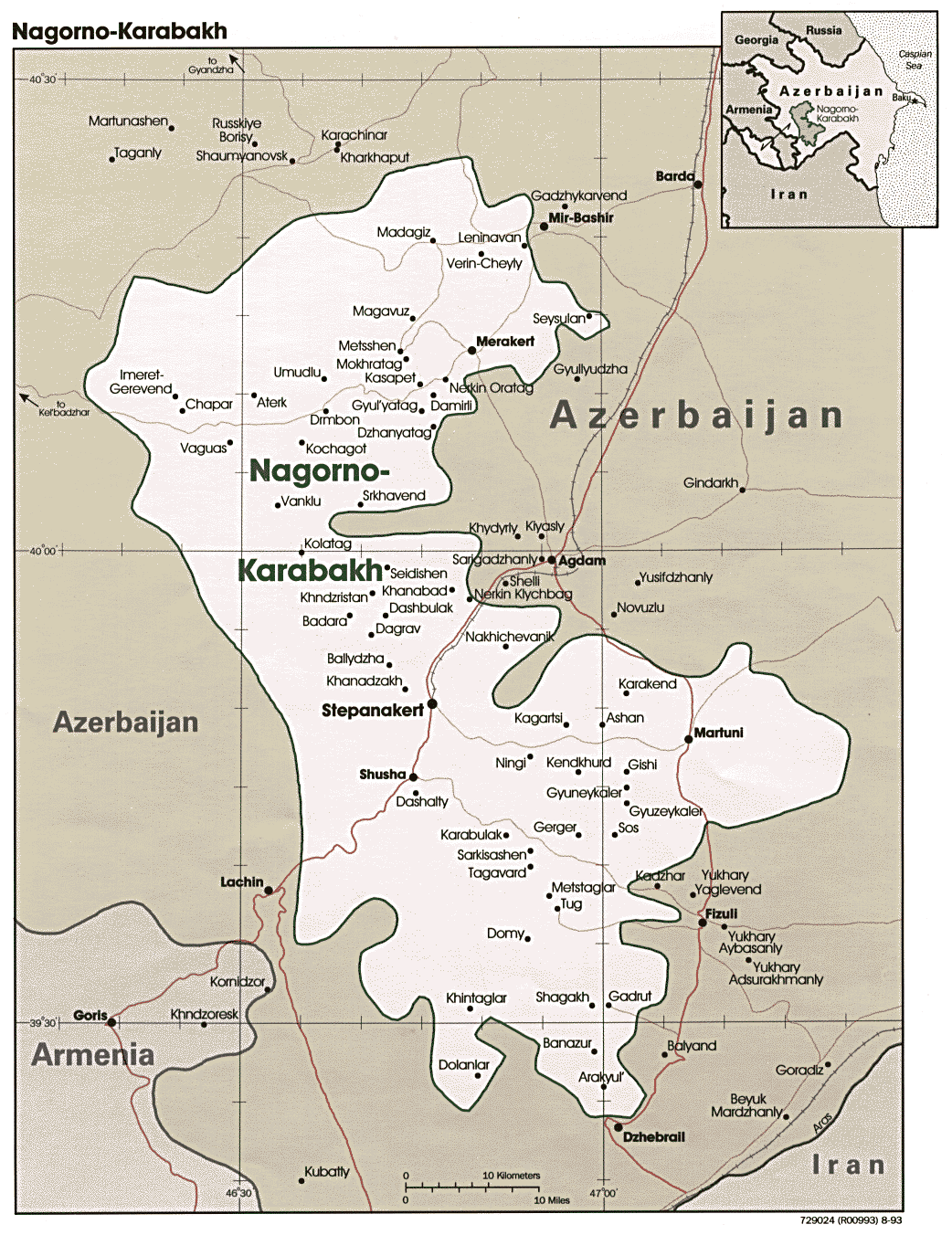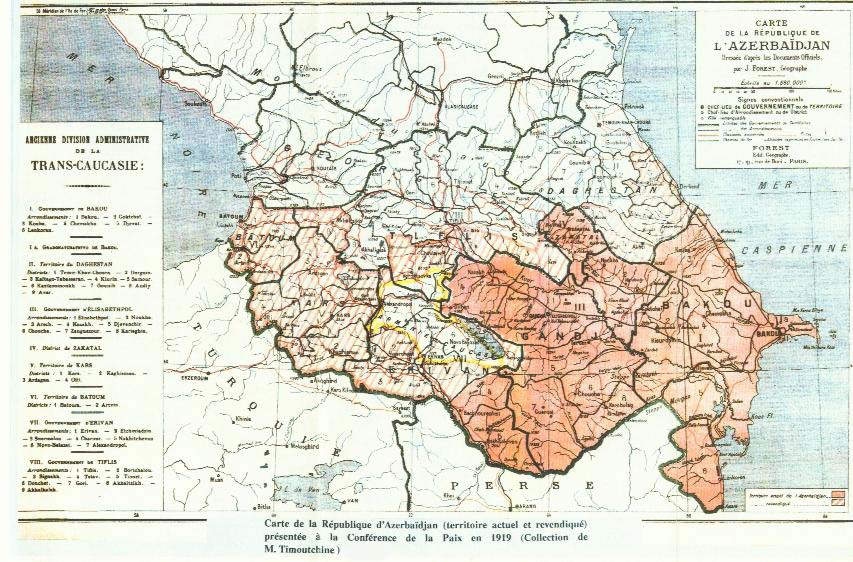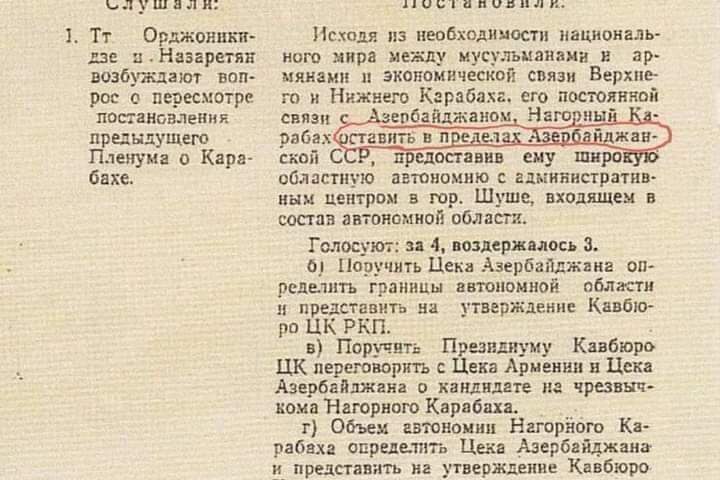In order to give an official character to the recognition of Armenia by Soviet Russia, G. Chicherin attempted to convince G. Ordzhonikidze that for Soviet Russia, a compromise was necessary with the Armenia’s Dashnak government. He wrote: “The Azerbaijan government declares disputable not only Karabakh and Zangazur, but also the Sharur-Daralagez district. The latter never has been declared a matter of dispute, and even the Musavat government always recognized it as part of Armenia. Without it, almost nothing would remain of Armenia. The Armenian peace delegation after lengthy resistance agreed to recognize Karabakh and Zangazur as disputable hoping that at the end of the day a significant portion of these localities will be given to Armenia, but they in no case agreed to recognize Sharur-Daralagez district as a matter of dispute. On the other hand, we must achieve agreement from the Azerbaijani government so that our treaty with Armenia will not be in contradiction with the demands of Azerbaijan. Given the enormity of your influence in Baku, we ask You to use it in order to get from the Azerbaijan government its assurance that it considered Karabakh and Zangazur matters of dispute, but not Sharur-Daralagez district. [7]
After Chicherin’s code cable of July 2, 1920 and discussion with the newly assigned plenipotentiary representatives of Soviet Russia in Armenia B. Legran and A. Gabrielyan, G. Ordzhonikidze by direct line reported to Moscow the following: “Azerbaijan insists on the immediate and unqualified recognition of Karabakh and Zangazur as part of its territory. In my opinion, this is necessary to do since both districts are economically drawn to Baku and are completely cut off from Yerevan, especially now with the Bayazet Turkish division cutting them off. According to the words of Comrade Gabrielyan, the Armenian delegation unconditionally will go along. With this resolution of the issue, Azerbaijan can be forced to agree to the cession of the remaining territories. My opinion is the following: Karabakh and Zangazur must be immediately joined to Azerbaijan. I will force Azerbaijan to declare these regions autonomies, but this must come from Azerbaijan and not in any case must be mentioned in the treaty [with Armenia].” [8]
In another report to V.I. Lenin, I. Stalin and G. Chicherin on direct line, G. Ordzhonikidze openly reported that the Armenian government was intentionally introducing confusion on these issues: “Today Gabrielyan declared to me that the Armenian delegation, if Azerbaijan dropped its claims on Sharur-Daralagez district and the Nakhchivan district, would agree to the immediate unification of Karabakh and Zangazur to Azerbaijan. We agreed that on our arrival to Baku we would discuss this with Narimanov. As you see, there is no lack of clarity or understanding here. I can assure you that we quite clearly represented our peace policy and will continue to carry it out. I am certain and this is my deep conviction that for the strengthening of Soviet power in Azerbaijan and out continued holding of Baku, it is necessary to unite Nagorno-Karabakh [with Azerbaijan] and that there cannot be any vacillation about the plain portion of it. It was always Azerbaijan. Azerbaijan will guarantee the security of the Armenian population of this district with its head. We will declare an autonomy here and promise the Armenian population that it will be protected and that Muslim military units will not be introduced there.”
G. Ordzhnokidze warned that “a different decision on this issue will threaten our position in Azerbaijan and will win us nothing in Armenia. I completely well understand that the possibility cannot be excluded that we may need Armenia under certain political circumstances. Decide as you see necessary. We will follow all your directions. But permit me to bring to Your attention that such an attitude to Azerbaijan will strongly compromise us in the eyes of the broad masses of Azerbaijan and benefit to the highest degree our opponents.” [9]
After the April 1920 turn of events, G. Ordzhonikidze for a certain time in Azerbaijan-Georgian and Azerbaijan-Armenian relations took the side of Azerbaijan, which was considered “Soviet Russia’s firstborn in the East,” and this seriously disturbed some in Moscow and particularly in the Peoples Commissariat for International Affairs. G. Chicherin, who headed this group, opposed Ordzhonikidze and called his position “concealed Orientalist and Muslimophile.” In response to this, G. Ordzhonikidze said that his views had no relation to Muslim nationalism and that in his family there is not a single Tatar. [10]
G. Ordzhonikidze knew perfectly well who in the Center was muddying the waters and therefore in his transmission of the next reports by direct line he asked N. Alliluyeva to report to Stalin that Chicherin and Karakhan were again putting him “here in a hopeless position.” [11] G. Chicherin showed an entirely different position when he wrote to Ordzhonikidze a telegram on July 8, which said the following: “We know quite well that the moment for Sovietization is also coming to Armenia, but to go in that direction now is premature. The most important thing which can be achieved now is the declaration of Karabakh and Zangazur as disputed regions, and for this it is necessary that the Azerbaijani government give its agreement. We need this [because] we absolutely must conclude a treaty with Armenia. The world situation requires this, and for this we must declare Karabakh and Zangazur, but no more, subjects of dispute.” [12]
G. Chicherin and L. Karakhan directed the policy of the Peoples Commissariat for International Affairs concerning cooperation with Armenia at the expense of Azerbaijan. Not having been able to block this policy, G. Ordzhonikidze on July 16 sent a telegram to V.I. Lenin, I. Stalin and G. Chicherin containing a request that peace with Armenia not be concluded prior to the arrival of the Azerbaijani delegation. He wrote: “Peace with Armenia without the participation of Azerbaijan will seriously disturb comrades here.” [13] A. Mikoyan, a member of the Central Committee of the ACP(b), shared these positions and on June 29, he wrote to Ordzhonikidze: “We are indignant at the policy of the Center as regards Karabakh and Zangazur. You also defend our point of view before the Center. We are not against peace with Armenia, but in no case at the price of Karabakh and Zangazur.” [14]
As we can see, it looked very strange that Soviet Russia and Dashnak Armenia were conducting secret negotiations concerning Azerbaijan without its participation and agreement. What was taking place with Armenia was actually an exact reflection of what had occurred with Georgia a month earlier. Then, there were many interesting places in the coded portion of the telegram which Ordzhonikidze and Kirov sent to Lenin and Stalin. They considered that the conclusion of an agreement with Georgia without the clarification of the position of Azerbaijan would lead to the failure of Soviet policy. Ordzhonikidze and Kirov wrote the following: “Why in concluding a treaty with Georgia are we refusing to conclude a treaty with fraternal Azerbaijan. If the Azerbaijani question is decided otherwise, please inform us.” Then by special code, they warned the Center: “Not in any case should Karakhan be allowed to be the leader of eastern policy. The entire Zakatala scandal [a reference to the promise to transfer the Zakatala district to Georgia according to the Moscow Treaty of May 7, 1920] is understood here as the work of an Armenian.” [15]
There is no doubt that L. Karakhan played an important role in the formation and implementation of the anti-Azerbaijani policy of the NKID of Soviet Russia. Both coded and open documents of that time point to his intrigues in the Karabakh question. For example, G. Ordzhonikidze openly wrote: “Karabakh is a second Zakatala of our foreign commissariat. Here is taking place a colossal provocation, which is being carried out by Armenians in Moscow.” [16]
However, despite the strong pressure of the Center on Azerbaijan, it was not able to achieve its rapprochement with the position of Armenia. The negotiations of S. Kirov with Peoples Commissar M.D. Huseynov and the Armenian representatives in Tiflis failed to yield results. On August 6, he wrote to Chicherin that, as a result, he was able to gain only one thing from the Azerbaijanis: they were ready to yield to Armenians the Sharur-Daralagez district, but the rest, that is Nakhchivan district, Ordubad, Dzhulfa, Zangazur, and Karabakh, the Azerbaijanis decisively considered their own. In their turn, the Armenian representatives insisted on all these areas. The chief argument of the Azerbaijanis was that these oblasts belonged to Azerbaijan at the time of the Musavat government and yielding them now would harm Soviet power in the eyes of Azerbaijanis, Iran and Turkey. [17]
As a result of the negotiations conducted in Moscow and Yerevan, on August 10, 1920 was concluded an agreement consisting of six sections. Four of them were devoted to the artificially created territorial dispute with Azerbaijan. In the second section of the treaty, it was noted that with the exception of areas defined by the current agreement for the dislocation of forces of Armenia; the forces of the RSFSR will be dislocated in the districts of Karabakh, Zangazur and Nakhchivan, which are to be considered matters of dispute. The third paragraph specified that “the disputed territories occupied by Soviet forces do not pre-decide the issue about the rights on these territories of the Republic of Armenia and the Azerbaijan Socialist Soviet Republic. By its provisional occupation, the RSFSR has in mind the creation of favorable conditions for the peaceful resolution of territorial disputes between Armenia and Azerbaijan on the basis of the provisions which will be established by a peace treaty which is to be concluded by the RSFSR and the Republic of Armenia in the nearest future.” [18]
As a matter of fact, the speed at which the treaty between Russia and Armenia was concluded is explained by the fact that on exactly the same date was concluded the Sevres Treaty between Turkey and the Entente. The Sevres Treaty promised the Armenians great dividends and Soviet Russian diplomacy was concerned that Armenia might entirely fall under the influence of the Entente. The Sevres Treaty became the chief external factor which forced G. Chichern speedily to conclude the agreement with Armenia. And the even not yet prepared as a diplomatic document, this agreement under pressure from Moscow was signed, and the Azerbaijani lands which were transformed by Soviet Russia into disputed ones were promised to Armenia.
From the very first days of the Sovietization of Azerbaijan, preparations were carried out so that the indisputable lands of Azerbaijan were declared disputable, which is what we see in the Russian-Armenian accord. G. Ordzhonikidze, who had been sent to Azerbaijan, on June 19, 1920, sent a telegram to V.I. Lenin and G. Chicherin reporting that in Karabakh and Zangazur, Soviet power had been proclaimed and that both these territories consider themselves part of Azerbaijan. He warned: “Azerbaijan cannot get along in any way without Karabakh and Zangazur. In general, in my opinion, a representative of Azerbaijan should be called to Moscow and together with him be resolved all questions concerning Azerbaijan and Armenia, and this should be done before the signing of an agreement with Armenia [because] a repetition of the Zakatala events by the Armenians would end with undermining our position here.” [19]
The August 10 agreement concluded between Soviet Russia and Armenia without Azerbaijan being informed, however, was the result of a policy chosen by the Central Bolshevik government and particularly the Peoples Commissariat of International Affairs of Soviet Russia, which was directed at harming the interests of Azerbaijan.
In the territorial disputes of the two republics, someone very much wanted that Armenia would win. For this, certain leading workers at the Center were not averse to using deception or even provoking elements. Long before the signing of the accord [with Armenia], G. Chicherin in a report suggested to V. Lenin that “the Azerbaijan government has made a claim on Karabakh, Zangazur, and Sharur-Daralagez district along with Nakhchivan, Ordubad, and Dzhulfa … To support this combination through the use of Russian units is totally impermissible. Our role must be absolutely objective and strictly dispassionate. It would be a fatal mistake for all our policy in the East if we were to begin to base ourselves on one national element against another national element. To take from Armenia some portions and hand them over to Azerbaijan would mean to give a false coloration to all our policy in the East.” [20] Chicherin was then able to include part of his proposals in the official instructions sent to the Revolutionary Military Council of the Caucasus Front, where he in the name of the Central Committee of the party instructed them not to allow Azerbaijani or Armenian organs into the disputed territories. However, the territories he declared disputed were in fact the territories of Azerbaijan and were under the control of Azerbaijani organs of power, which means that the directive of Chicherin was a crude violation of the sovereign rights and territorial integrity of Azerbaijan.






